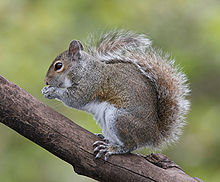
Summary
Compassionate conservation is a discipline combining the fields of conservation and animal welfare. Historically, these two fields have been considered separate[1] and sometimes contradictory to each other.[2] The foundational principles of compassionate conservation are: "Do No Harm; Individuals Matter; Inclusivity; Peaceful Coexistence".[3]

Compassionate conservationists argue that the conservation movement uses the preservation of species, populations and ecosystems as a measure of success, without explicit concern given to the welfare and intrinsic value of individual animals.[4] They argue instead, that compassion for all sentient beings should be what guides conservation actions[5] and claim that the killing of animals in the name of conservation goals is unnecessary, as these same objectives can be achieved without killing.[6]
Compassionate conservation has been a subject of criticism by some conservationists, who consider the discipline to be harmful to the goals of conservation.[7][8]
History edit
The international wildlife charity Born Free Foundation, which advocates for the well-being of individual wild animals, used the phrase "compassionate conservation" as the name for a Oxford-based symposium it hosted in 2010.[9] The Centre for Compassionate Conservation was created, in 2013, at the University of Technology, Sydney.[10] Ignoring Nature No More: The Case for Compassionate Conservation, a collection of essays edited by compassionate conservation advocate Marc Bekoff, was published in the same year.[11]
In the years since, further conferences have been held on the topic and advocates have published multiple articles in conservation journals.[9]
Criticism edit
Compassionate conservation has been called "seriously flawed" by certain conservationists, who argue that its implementation is impractical and could lead to negative outcomes for wildlife, ecosystems, humans[7] and native biodiversity.[8] Others argue that the "do no harm" approach goes "too far" and that put into practice, it would not necessarily lead to positive outcomes for the welfare of individual animals.[12] Andrea S. Griffin et al. argue that compassionate conservation's focus on empathy "is subject to significant biases and that inflexible adherence to moral rules can result in a 'do nothing' approach".[8]
See also edit
References edit
- ^ Fraser, D. (May 2010). "Toward a synthesis of conservation and animal welfare science". Ingenta Connect. Retrieved 2020-04-20.
- ^ Gray, Jenny (2018-08-31). "Challenges of Compassionate Conservation". Journal of Applied Animal Welfare Science. 21 (sup1): 34–42. doi:10.1080/10888705.2018.1513840. ISSN 1088-8705. PMID 30325231.
- ^ Wallach, Arian D.; Bekoff, Marc; Batavia, Chelsea; Nelson, Michael Paul; Ramp, Daniel (2018). "Summoning compassion to address the challenges of conservation". Conservation Biology. 32 (6): 1255–1265. doi:10.1111/cobi.13126. ISSN 1523-1739. PMID 29700860. S2CID 23206524.
- ^ Ramp, Daniel; Bekoff, Marc (2015-03-01). "Compassion as a Practical and Evolved Ethic for Conservation". BioScience. 65 (3): 323–327. doi:10.1093/biosci/biu223. hdl:10453/34122. ISSN 0006-3568.
- ^ Wallach, Arian D.; Batavia, Chelsea; Bekoff, Marc; Alexander, Shelley; Baker, Liv; Ben‐Ami, Dror; Boronyak, Louise; Cardilini, Adam P. A.; Carmel, Yohay; Celermajer, Danielle; Coghlan, Simon (2020). "Recognizing animal personhood in compassionate conservation". Conservation Biology. 34 (5): 1097–1106. doi:10.1111/cobi.13494. ISSN 1523-1739. PMC 7540678. PMID 32144823.
- ^ Keim, Brandon (2014-06-04). "Do Conservation Strategies Need to Be More Compassionate?". Yale E360. Retrieved 2020-04-20.
- ^ a b Oommen, Meera Anna; Cooney, Rosie; Ramesh, Madhuri; Archer, Michael; Brockington, Daniel; Buscher, Bram; Fletcher, Robert; Natusch, Daniel J. D.; Vanak, Abi T.; Webb, Grahame; Shanker, Kartik (2019). "The fatal flaws of compassionate conservation". Conservation Biology. 33 (4): 784–787. doi:10.1111/cobi.13329. ISSN 1523-1739. PMID 30977162. S2CID 109939975.
- ^ a b c Griffin, Andrea S.; Callen, Alex; Klop-Toker, Kaya; Scanlon, Robert J.; Hayward, Matt W. (2020). "Compassionate Conservation Clashes With Conservation Biology: Should Empathy, Compassion, and Deontological Moral Principles Drive Conservation Practice?". Frontiers in Psychology. 11: 1139. doi:10.3389/fpsyg.2020.01139. ISSN 1664-1078. PMC 7269110. PMID 32536896.
- ^ a b Marris, Emma (2018-09-26). "When Conservationists Kill Lots (and Lots) of Animals". The Atlantic. ISSN 1072-7825. Retrieved 2020-04-27.
- ^ Gray, Jenny (2017). Zoo Ethics: The Challenges of Compassionate Conservation. Csiro Publishing. p. 180. ISBN 978-1-4863-0699-2.
- ^ Bekoff, Marc (2013-04-16). "Ignoring Nature No More: Compassionate Conservation at Work". Psychology Today. Retrieved 2020-05-11.
- ^ Johnson, Paul J.; Adams, Vanessa M.; Armstrong, Doug P.; Baker, Sandra E.; Biggs, Duan; Boitani, Luigi; Cotterill, Alayne; Dale, Emma; O’Donnell, Holly; Douglas, David J. T.; Droge, Egil (December 2019). "Consequences Matter: Compassion in Conservation Means Caring for Individuals, Populations and Species". Animals. 9 (12): 1115. doi:10.3390/ani9121115. PMC 6941047. PMID 31835670.
External links edit
- Compassionate Conservation (archived 21 January 2020)
- Centre for Compassionate Conservation


